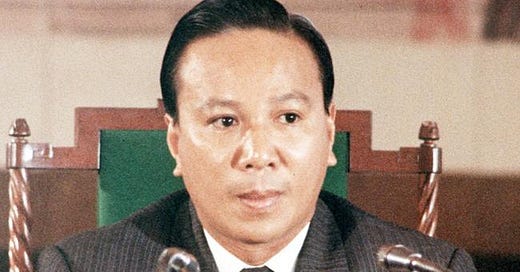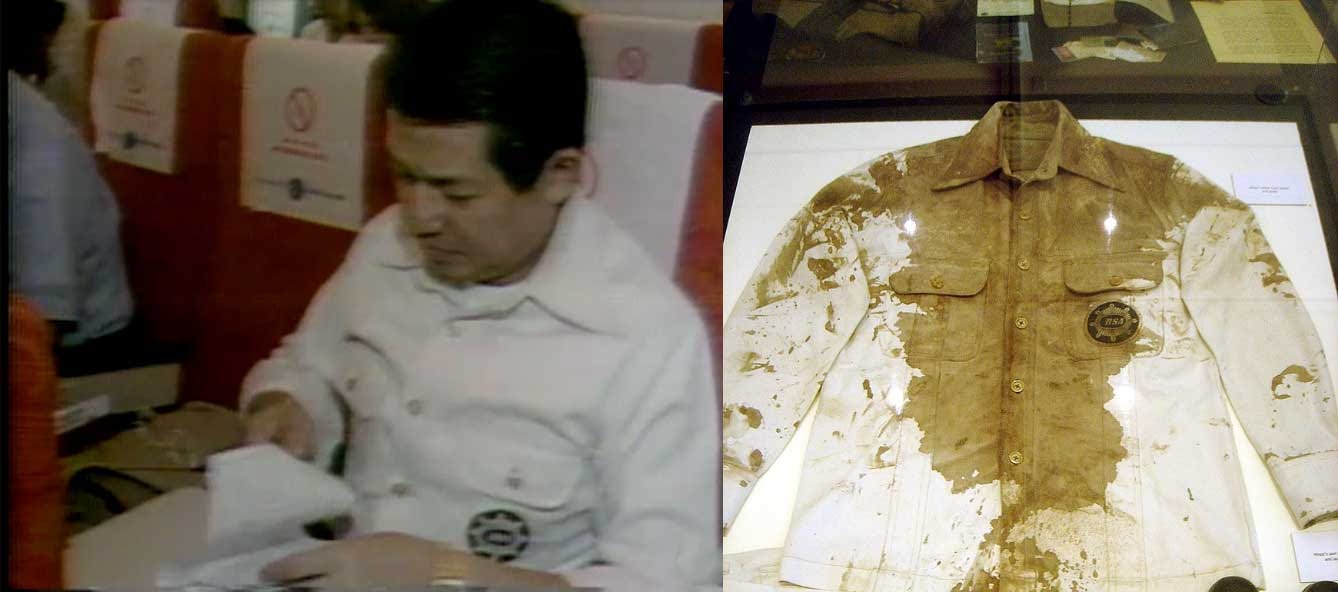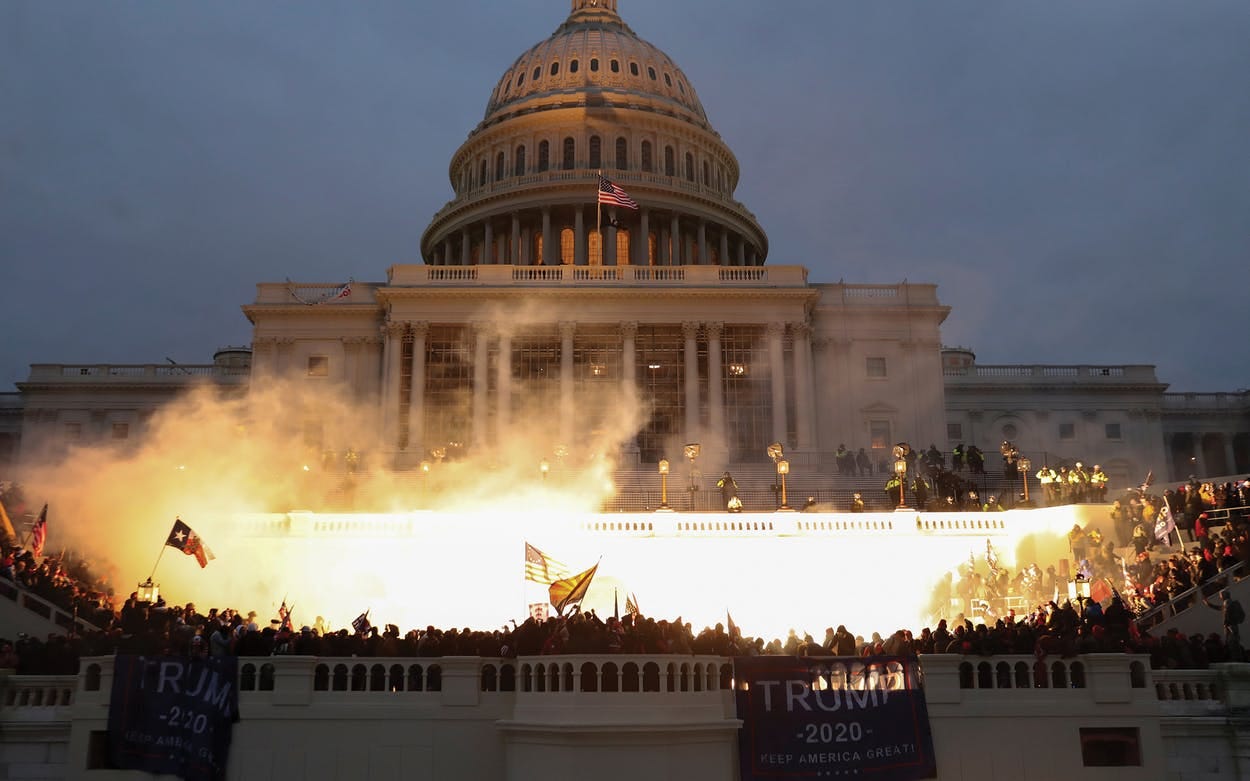“I am the commander in chief. I will not abandon my people...I am willing to die for my country.”
"Remobilizing the Afghan security and defense forces is our top priority... I assure you I will prevent further instability."
Those were the words of Afghan president Ashraf Ghani. The first statement was from May, and the second statement just one day before abruptly fleeing by plane over the weekend.
The chaotic scenes out of Afghanistan before the Taliban’s takeover has me thinking about how the last days of ousted leaders– and their often ignominious final speeches– are fascinating and revealing documents:
Sometimes they try to bargain with their opponents for a chance to hang on to power
Other times they seem resigned to their fate, asking for forgiveness
And still other times they seem in denial about impending doom
So today, with the help of Wikipedia, I want to take you on a whistle-stop tour of five remarkable final public addresses from various leaders during their last moments in power. Some of these "last speeches" are truly wild. And even if you're not old enough to remember all five of them, I guarantee the last one on this list will ring a bell.
1. President Thiệu's angry, incoherent resignation speech in South Vietnam, 1975
The Vietnam War pitted the communist North Vietnamese army supported by China and the Soviet Union against the pro-Western South Vietnamese government, supported by the United States.
For the second half of the war, South Vietnam was led by former general Nguyễn Văn Thiệu. By 1975, the US had already withdrawn its troops after domestic public opinion soured and Congress refused to fund the war any longer. With a ceasefire between the North and South having fallen apart, President Thiệu made a series of strategic miscalculations and North Vietnamese troops marched south toward the capitol, Saigon. Here is how Wikipedia describes Thiệu's final speech:
In his televised farewell speech during which he was close to tears, he admitted, for the first time, having ordered the evacuation of the Central Highlands and the north that had led to debacle. He then stated that it had been the inevitable course of action considering the situation, but still blamed the generals.
In a rambling and incoherent speech, Thiệu went on to excoriate the U.S., attacking "our great ally, [the] leader of the free world". "The United States has not respected its promises" he declared. "It is inhumane. It is not trustworthy. It is irresponsible."
He added, "The United States did not keep its word. Is an American's word reliable these days?", and "The United States did not keep its promise to help us fight for freedom and it was in the same fight that the United States lost 50,000 of its young men."
Although Thiệu declared in his speech "I resign, but I do not desert," he later boarded a transport plane to Taiwan with a "planeload of suitcases containing heavy metal" that were later revealed to be gold.
After blaming the United States for the loss of South Vietnam, he ironically decided to live out his final days in the US, dying in Massachusetts in 2001. He never wrote a memoir and rarely agreed to interviews, apparently afraid of facing South Vietnamese refugees who also made the US their home who blamed him for the loss of the war.
2. Ceaușescu's chaotic botched last speech in Romania, 1989
Soviet-aligned dictator Nicolae Ceaușescu led Romania for 24 years. But by 1989, his grip on the country had loosened and even his notoriously brutal secret police, known as Securitate, weren't enough to stop his cult of personality from disintegrating.
Ceaușescu had cultivated a public image of popularity, even while the country suffered from poverty and malnutrition. Wikipedia notes that his reign was punctuated by "weekly shows in stadiums or on streets in different cities dedicated to him, his wife and the Communist Party."
On December 21 1989, he gave one final grand speech that backfired spectacularly. Eager to create the appearance of a popular ruler, the dictator's security forces rounded up 100,000 random citizens, even bussing them in from nearby workplaces. Although they were instructed to cheer and clap, they were in no mood to serve as props for television. Wikipedia describes the dramatic scene that unfolded on live television:
Ceaușescu was out of touch with his people and completely misread the crowd's mood. The people remained unresponsive, and only the front rows supported Ceaușescu with cheers and applause. About two minutes into the speech, some in the crowd began to jeer, boo, whistle and yell insults at him, a reaction unthinkable for most of his rule.
Workers from a Bucharest power plant started chanting "Ti-mi-șoa-ra! Ti-mi-șoa-ra!" [the name of a city that had seen recent protests against the regime], which was soon picked up by others in the crowd. In response, Ceaușescu raised his right hand in hopes of silencing the crowd; his stunned expression remains one of the defining moments of the end of Communism in Eastern Europe.
He then tried to placate the crowd by offering to raise workers' salaries by 200 lei per month (about 19 U.S. dollars at the time, yet a 5%–10% raise for a modest salary) and student scholarships from 100 to 110 lei while continuing to praise the achievements of the Socialist Revolution. However, a revolution was brewing right in front of his eyes.
As Ceaușescu was addressing the crowd from the balcony of the Central Committee building, sudden movement came from the outskirts of the massed assembly, as did the sound of (what various sources have reported as) fireworks, bombs or guns, which together caused the assembly to break into chaos. Initially frightened, the crowds tried to disperse. Bullhorns then began to spread the news that the Securitate was firing on the crowd and that a "revolution" was unfolding. This persuaded people in the assembly to join in. The rally turned into a protest demonstration.
The entire speech was being broadcast live nationwide. Censors attempted to cut the live video feed and replace it with Communist propaganda songs and video praising the Ceaușescu regime, but parts of the riots had already been broadcast and most of the Romanian people realized that something unusual was in progress. Ceaușescu and his wife, as well as other officials and CPEx members, panicked; Ceaușescu's bodyguard hustled him back inside the building.
Ceaușescu and his wife probably should have fled instantly. But instead he waited until the next day when a helicopter landed within his palace grounds on a terrace to take him away. The pilot recalled: "The Ceaușescus came out, both practically carried by their bodyguards ... They looked as if they were fainting. They were white with terror." As the helicopter took off from a terrace on the palace, protestors broke through and almost caught them!
Within 24 hours, the military had abandoned Ceaușescu. The revolution was swift, leaving the dictator and his wife with only a loyal bodyguard or two. He was swiftly arrested after fleeing to the countryside. A brief 2 hour trial was held and Ceaușescu and his wife were hastily executed on Christmas by firing squad. So hastily that the TV crew that had been roped into filming the proceedings barely turned on their cameras in time to catch the last ricochet of gunfire.
Wikipedia notes that it was the "the last removal of a Marxist-Leninist government in a Warsaw Pact country during the events of 1989, and the only one that violently overthrew a country's leadership and executed its leader." Perhaps a testament to his brutality – or rumors that loyalists would try to reinstate him quickly in a counter-revolution. You can't reinstate a dead dictator.
3. The Shah of Iran's last ditch apology speech that backfired, 1979
From the 1950s to the 1970s, the US supported a pro-western monarchy in Iran. The king, or Shah, sought to secularize and modernize his country.
But wide swaths of the country weren't ready for these changes, and it didn't help that his reign was enforced by an unaccountable secret police SAVAK that repressed dissent as many common Iranians were left behind by the economic transformation that the Shah was attempting. By late 1978 the aging Shah's grip on power loosened and the country began to spiral into chaos, as different factions vied for power, including followers of the strict islamic cleric Ruhollah Khomeini who had been living in exile in France. Here's Wikipedia on the Shah’s apology at the end of a 25 year reign:
The Shah made a speech on Iranian television. He referred to himself as Padeshah ('Master King'), instead of the more grandiose Shahanshah (king of kings), which he insisted on being called previously.
In his speech he stated "I have heard the voice of your revolution...this revolution cannot but be supported by me, the king of Iran." He apologized for mistakes that were committed during his reign, and promised to ensure that corruption would no longer exist. He stated he would begin to work with the opposition to bring democracy, and would form a coalition government.
In effect, the Shah intended to restrain the military government (which he described as a temporary caretaker government) from carrying out a full crackdown. The speech backfired when the revolutionaries sensed weakness from the Shah and "smelled blood". Khomeini announced that there would be no reconciliation with the Shah and called on all Iranians to overthrow him.
Although the Shah ordered his secret police chief jailed for abuse of the people, it was too little too late. Within a month, Iran was in open revolution. The Shah fled for Egypt on January 16. After the revolution when he was allowed to enter the United States for cancer treatment, many young Iranian supporters of Ayatollah Khomeini feared the US might be reinstate him as king of Iran once again.
They took US embassy staff hostage for 444 days, demanding the Shah returned to Iran for a trial. The embassy hostages were eventually released peacefully after the Shah died of cancer, but US-Iranian relations were irreparably damaged for the foreseeable future. Khomeini died 9 years later, having returned to his home country and successfully re-establishing Iran as an Islamic Republic – in some ways the opposite of the future the Shah had been trying to build.
4. Filipino dictator Marcos quarrels with his top general on live television in his final hours
The Philippines was ruled by the iron grip of Ferdinand Marcos for two decades. During this time he allegedly embezzled billions of dollars from the government. But it took only 3 days for his rule to fall apart in the People Power Revolution.
Marcos' primary political opponent senator Benigno Aquino had been exiled to live in the United States. Knowing he was popular among the people, Aquino decided to return to his country in 1983, dismissing the regime's threats saying "The Filipino is worth dying for."
He seemed to know what was coming. He told journalists on the plane with him: "You have to be ready with your hand camera because this action can become very fast. In a matter of three or four minutes it could be all over, and I may not be able to talk to you again after this."
Just after disembarking from the airplane wearing a bulletproof vest, Aquino was shot in the head at the airport, supposedly by a lone gunman (video). The man alleged to be the gunman was, himself, killed instantly by security forces on the tarmac.
Although the notoriously corrupt Marcos likely saw Aquino's assassination as a triumph with plausible deniability since the apparent gunman was dead, it was was the beginning of the end for his time in power. Two million people attended Aquino's funeral. In the minds of the people, Marcos was ultimately the one to blame. And confusion over who fired the gun that killed Aquino and who arranged the killing muddied the waters further.
Aquino's widow named Corazon ran against Marcos for president in the election in 1986. Although Marcos declared himself the winner, nobody believed the vote tally his administration provided.
Widespread demonstrations led to military defections. On February 24 an impromptu press conference was convened. Marcos sat at a desk surrounded by his remaining loyal military leaders, including general Fabian Ver, who had allegedly been involved in the assassination of Aquino, years earlier. On live television, General Ver tried frantically to convince Marcos to allow his men to the gathered slaughter protestors but Marcos, knowing he was surrounded by journalists, sensed this was an impossible order to give at least publicly, and he flinched:
General Ver: The Ambush there is aiming to mount there in the top. Very quickly, you must immediately leave to conquer them, immediately, Mr. President.
Ferdinand Marcos: Just wait, come here.
Ver: Please, Your Honor, so we can immediately strike them. We have to immobilize the helicopters that they've got. We have two fighter planes flying now to strike at any time, sir.
Marcos: My order is not to attack. No, no, no! Hold on. My order is not to attack.
Ver: They are massing civilians near our troops and we cannot keep on withdrawing. You asked me to withdraw yesterday–
Marcos (interrupting): Uh yes, but ah... My order is to disperse without shooting them.
Ver: We cannot withdraw all the time...
Marcos: No! No! No! Hold on! You disperse the crowd without shooting them.
Despite inaugurating himself for another term as president as president, the next day in the early morning of February 26, Marcos fled the country. The rightfully elected Ms Aquino took power, put an end to martial law, and instituted democratic reforms. She left power peacefully in her own Toyota after serving a single six year term in office. She died in 2009, having outlived Marcos by three decades.
5. Donald Trump's Jan 6 speech inciting a riot
After losing in a landslide election to Joe Biden, outgoing president Donald Trump tried to cling on to power, demanding state election officials invalidate their own vote counts. We now know he also tried to pressure the Department of Justice to nullify the 2020 election results.
Failing that, on the day of the electoral college vote in Congress, Trump helped organize a massive event in Washington. After having previously instructing his white supremacist supporters such as the Proud Boys gang to "stand by" for future orders, Trump finally gave them in a rambling speech on January 6, instructing his followers: "We're going to walk down, and I'll be there with you."
"You have to show strength and you have to be strong..."
"I said something's wrong here, something is really wrong, can have happened. And we fight. We fight like hell. And if you don't fight like hell, you're not going to have a country anymore."
Before he thanked them, Trump's final words to the crowd were "let's walk down Pennsylvania Avenue."
Moments later, the crowd followed his orders, taking over the US Capitol building, killing police officers who tried to defend it, and searching for legislators to kill or take hostage. "Hang Mike Pence!" they chanted, after Trump's Vice President declined to take unconstitutional action to preserve his presidency.
As the violence unfolded that day, Donald Trump was banned from all major social media platforms for breaking their platform rules against inciting violence. He left office on January 20, 2021, as the first president in over 100 years declining to attend his successor's inauguration.
That's all I've got for you this month
Stay safe.
If you found this edition of my forgotten history newsletter interesting, please consider sharing it on social media or forwarding this email. If you haven't subscribed to my free monthly history stories, you can do so below. I also get a happy email alert every time someone "likes" this post.
Your friend in history,
Arlen
Share this post:
Subscribe to this free forgotten history newsletter:







